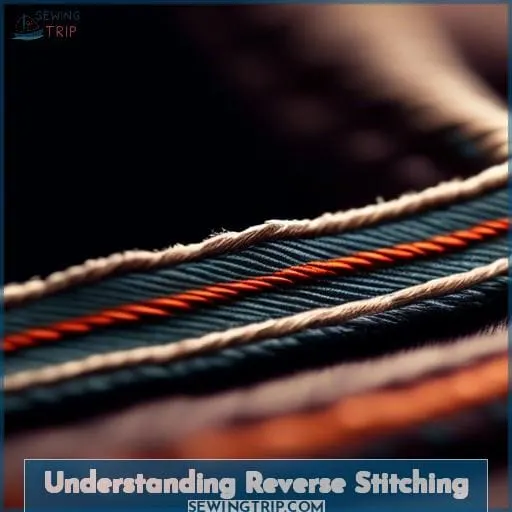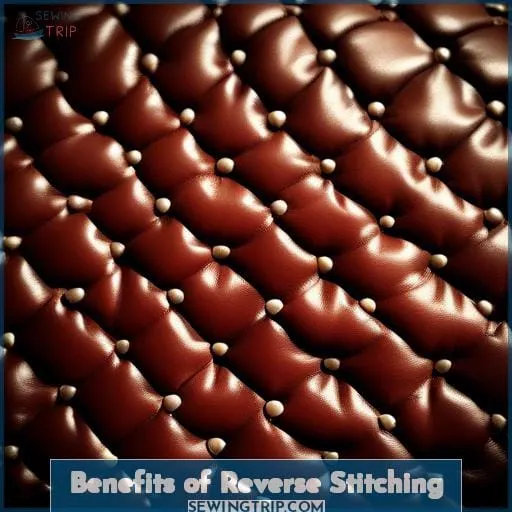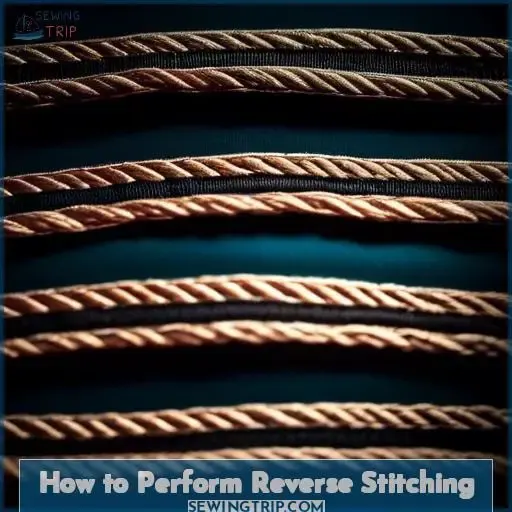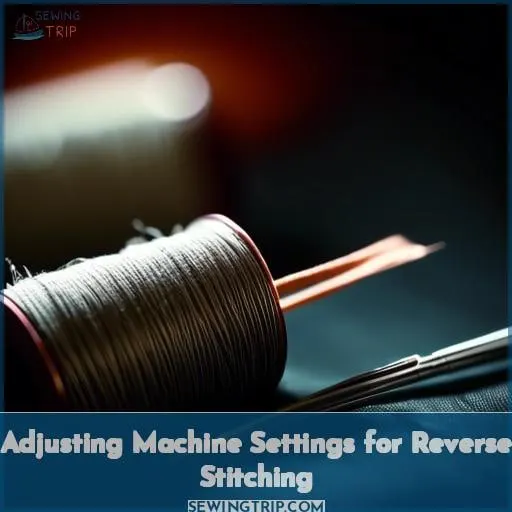This site is supported by our readers. We may earn a commission, at no cost to you, if you purchase through links.
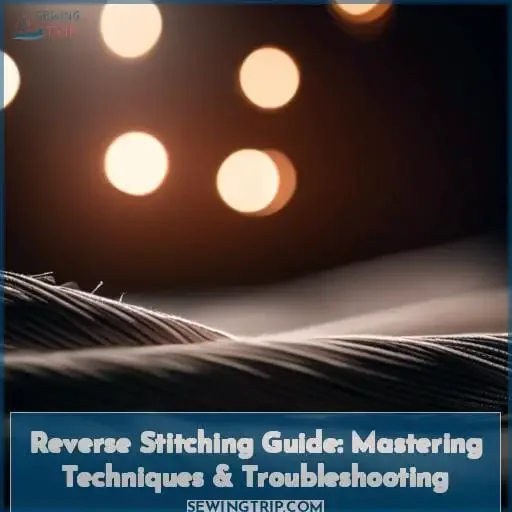 Over 80% of sewers experience seam frustrations, but mastering reverse stitching can change that.
Over 80% of sewers experience seam frustrations, but mastering reverse stitching can change that.
You’ll learn to reinforce and secure your stitches, ensuring your creations withstand the test of time.
This guide will walk you through the technique, from machine settings to troubleshooting common issues.
Embrace reverse stitching to elevate your sewing prowess and bring precision to your projects.
Let’s dive into the intricacies of this essential skill and solve those pesky stitch problems once and for all.
Table Of Contents
Key Takeaways
- Reverse stitching reinforces and secures stitches at the beginning and end of seams, preventing them from unraveling and ensuring the durability of the garment.
- It is performed by sewing a few stitches forward, pressing and holding the reverse button to make several stitches backward, and then sewing forward again to complete the seam.
- Proper machine settings are crucial for effective reverse stitching, including adjusting needle length, matching thread type to fabric, and balancing fabric thickness with pattern density.
- Troubleshooting reverse stitching may involve adjusting the needle bar height, fine-tuning the timing, setting the correct reverse stitch length, checking thread tension, and consulting the user manual for specific machine instructions.
What is Reverse Stitching
Reverse stitching is a sewing technique where the stitch is sewn in the opposite direction to reinforce the start and end of a seam, preventing it from unraveling. This method is essential for ensuring the durability and quality of the seam in various sewing projects.
Understanding Reverse Stitching
Dive into the art of reverse stitching, a technique that turns the ordinary into the extraordinary. Imagine your sewing machine as a time traveler, capable of moving backward to reinforce and beautify your creations.
Reverse stitch patterns aren’t just about going back; they’re about adding strength and flair to your straight stitches. With each reverse stitch density adjustment, you’re not just sewing; you’re sculpting fabric.
The applications are as varied as your imagination, from securing seams to adding decorative touches.
But beware, the path to mastery is peppered with potential pitfalls. Reverse stitch troubleshooting becomes your best friend, helping you navigate through snags and tangles. And let’s not forget the variations! Each one offers a new twist, a fresh perspective on reverse sewing.
So, grab your machine and let’s stitch back into the future, where every thread tells a story.
Benefits of Reverse Stitching
Reverse stitching isn’t just a technique; it’s your secret weapon for durable, professional-looking seams.
By reinforcing the start and end, you ensure your projects stand the test of time and wear.
Strengthens Stitches
Reverse stitching is like your fabric’s trusty bodyguard. It beefs up those seams, making sure they don’t wimp out on you when the going gets tough.
It’s akin to a reinforcement stitch that’s got your back, ensuring every thread is tight and every stitch length is just right.
With spot-on needle bar height and timing, your seams will be unshakeable!
Secures Seam Beginnings and Ends
Just as a well-tied knot is the cherry on top of a shoelace, reverse stitching is the clincher for your seams.
It’s the guardian of fabric security, ensuring your thread’s durability doesn’t waver.
With a tap of the start/stop button and precise needle penetration, you’ll bolster stitch strength and seam reinforcement, making your creations not just beautiful, but battle-ready.
How to Perform Reverse Stitching
To start your stitch with precision, begin by sewing a few stitches forward.
Then, press and hold the reverse button on your sewing machine. This will allow you to make several stitches backward, directly over the stitches you just made.
This technique is crucial for reinforcing the start of your stitch, ensuring that it is secure and won’t unravel.
To end your stitch with the same level of confidence, continue sewing until you are near the end of your fabric.
Press the reverse button again and make a few backstitches over your existing stitches.
Finally, sew forward to the very end of your fabric. This method locks your stitches in place, preventing them from coming undone.
Starting the Stitch
Ready to kick off your reverse stitch adventure? Plant your needle firmly in the fabric jungle, then hit the gas with your trusty foot controller.
After a few warm-up stitches, slam that reverse button like you’re rewinding a funky track.
Voilà, you’ve just nailed the reverse stitch takeoff!
Ending the Stitch
As you wrap up your seam, think of reverse stitching as the grand finale. Push the reverse button, let your machine dance backwards for a few stitches, then glide forward to the edge.
If the fabric rebels, tweak the reverse stitch length and tension. Stuck? Check the automatic setting.
Adjusting Machine Settings for Reverse Stitching
To tailor your machine for reverse stitching, you’ll need to explore its automatic stitch settings.
If they’re not quite right, toggling the stitch setting can make all the difference.
Automatic Stitch Settings
- Machine Compatibility: Ensure your gadget’s on board with the change.
- Needle Length: Adjust according to the fabric’s sass.
- Thread Type: Match it with the fabric’s attitude.
- Fabric Thickness & Pattern Density: Balance these to avoid a stitchy situation.
Stitch Setting Toggle
Ready to tweak your machine’s mood swings? Flip the toggle settings like a pro chef’s pancake.
Power down, press the plus sign like you’re giving it a thumbs-up, and power up. Voilà! You’ve manually adjusted for stitch length perfection.
Compatibility check—some machines are divas with settings. Troubleshooting just got a dash easier, didn’t it?
Keep that seam dream alive!
Troubleshooting Reverse Stitching
When reverse stitching gives you grief, it’s often a sign that your machine’s needle bar or tension settings need a tweak.
Let’s tackle these common culprits to get your stitches back on track.
Needle Bar Adjustments
After mastering your machine’s settings, it’s time to fine-tune the needle bar. Here’s how to keep your reverse stitching on point:
- Set the needle bar height just right to avoid a stitchy situation.
- Nail the timing adjustments; it’s the secret sauce for seamless sewing.
- Get the reverse stitch length spot-on; it’s the cherry on top for durability.
Timing and Tension Issues
After nailing the needle bar height, let’s crack the code on timing and tension.
If your reverse stitch is playing hard to get, a timing adjustment might just be your knight in shining armor.
And don’t forget thread tension; it’s the secret sauce for smooth stitching.
Troubleshooting these can turn a tangled mess into a masterpiece of precision.
Keep at it, stitch wizard!
Frequently Asked Questions (FAQs)
Can reverse stitching be used on all fabrics?
Reverse stitching isn’t a one-size-fits-all; it’s a no-go on flimsy fabrics that throw a tantrum under tension.
But it’s a champ at locking in seams on sturdier materials.
How does reverse stitching affect thread consumption?
Just like a plot twist in your favorite mystery novel, reverse stitching thickens the thread of your sewing tale. It consumes more thread as it doubles back to ensure those stitch endings are as secure as Fort Knox.
Is reverse stitching suitable for decorative purposes?
Reverse stitching isn’t just for locking in those seams; it’s a secret weapon for adding flair to your projects.
Think of it as the cherry on top, making your decorative stitches pop and last longer.
Can I perform reverse stitching on manual machines?
Yes, you can whip up reverse stitching on manual machines, but it’s a bit like dancing backward in high heels.
You’ll manually pivot the fabric to backtrack, crafting those sturdy, secure seams with a twist of flair.
How does reverse stitching impact sewing speed?
Reverse stitching often slows down your sewing machine, making you press the pedal harder to maintain speed.
It’s like your machine’s taking a careful step back to ensure the stitch is locked in tight.
Conclusion
Reflecting on the statistic that over 80% of sewers face seam frustrations, mastering reverse stitching emerges as a game-changer.
By embracing this technique, you’re set to reinforce your stitches, ensuring your creations are durable and polished.
This guide has equipped you with the knowledge to adjust your machine settings, start and end stitches confidently, and troubleshoot common issues.
Let reverse stitching be your ally in crafting projects that stand the test of time, elevating your sewing expertise to new heights.

